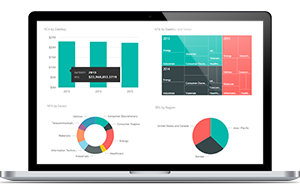Imagine that in 2017 someone is still actually posting letters because they think email is difficult and costly. Each time they have to bring their letters to a post office, where later a postman collects them to deliver. Delivery then takes at least a few days, while emails could be exchanged instantly. Inefficient and time-consuming, isn’t it? It’s surprising, but this is what some companies do when they overlook software for cash flow analysis and choose to carry on with Excel-based manual data processing.
BI consulting practitioners break the stereotype that only big companies need tech-based cash flow analysis and forecasting. In fact, midsized businesses need them too to keep track of their cash, and do it efficiently. Long gone the time when companies had no other alternatives than to go through the effort of using several Excel files, matching and filtering them manually to get a comprehensive picture. Now, the technology is convenient and affordable.

What can be analyzed?
A cash flow analysis answers a range of questions. For example, a real estate developer can check if there is enough cash to invest in a new project; a manufacturer whether external funding is needed to revamp the plant machinery; a retailer how much money is buried in stock; a bank if the cash flow is adequate to meet the liquidity coverage ratio.
These are just practicalities. The main question is whether a cash flow is sustainable.
To enable a comprehensive cash flow analysis and forecasting, a company can aggregate data from numerous sources:
- Cash flow history
- Planned and actual operating expenses and capital expenditures
- Accounts receivables/payable balances
- General ledger data
Besides, all the figures can be taken directly from the ERP modules (finance, accounting, sales, human resources, etc.). This means that all the values are kept up-to-date and can automatically turn from forecasted to actual, whenever confirmed.
The challenges solved with technology
Cash flow planning and forecasting
Cash flow analysis software will equip managers with timely, accurate and easy-to-use reports and charts giving an overview by geography, branches, bank account, etc. Cash forecasts can be generated automatically as frequent as necessary (daily, weekly, quarterly or monthly), as well as on demand. With such forecasts, financial managers will get an advance warning of cash shortage or surplus and will have time to take some actions (for instance, invest in company’s growth if there is free cash).
Project-level view
Big projects, both internal and for customers beyond the organization, may influence cash flow dramatically. Financial managers cannot treat big projects as black boxes, they need to look inside. For any project, it is necessary to know its duration, cost of each stage, terms of payment (prepayment or payment determent; a lump sum or by installments). Data analysis contributes to both an accurate cash plan and successful project implementation.
Risk management
With cash flow analysis software, a company has a reliable tool to manage risks. For example, a manufacturing company operates at a profit (its P&L says so) and wants to increase its production volume. However, the company’s cash flow forecast shows that there is not enough cash. Additionally, the software makes a quick projection with increased cost of goods produced, which shows that the company will only be losing money in a long-term perspective. A quick liquidity analysis helps to make the right decision.
A point of truth from different angles – instantly
Another advantage of a tech-based cash flow analysis is that the data from different sources is aggregated at the data warehouse level. For end users, this means fast response and a quick glance from different perspectives, as the system already has an answer to any question and just waits for a query. For example, financial managers can switch between the cash flow from operations to the cash flow from investing and then to the cash flow from financing all in a few clicks.
To sum up
Cash flow management is crucial to ensure that a business is healthy. A company that leaves its cash flow uncontrolled, risks to end up with insolvency and to ruin its reputation. Business intelligence services is there to help companies adopt the cash flow analysis technology that brings value, eliminates a big chunk of manual work, accelerates decision-making and solves such challenges as cash flow planning and forecasting, project-level view, risk management, and analysis from different perspectives in a few clicks.

Empower your business by replacing guesswork with informed decision-making. We’ll guide you through this challenging but value-bringing process.

